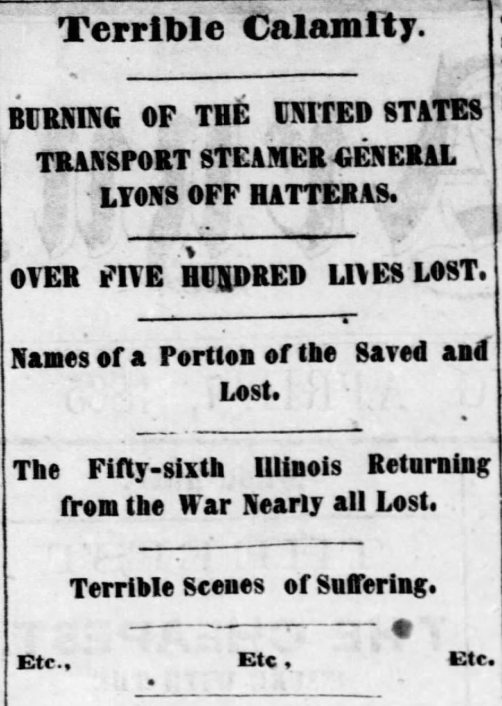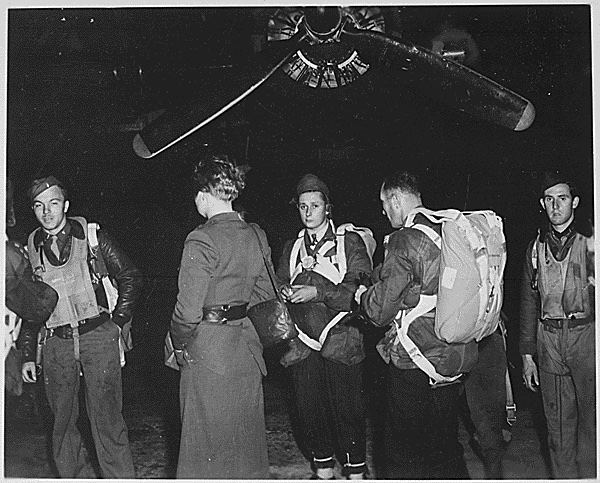March 31st is the 160th anniversary of one of the most shocking events of the Civil War: the fire and sinking of the Union transport ship, the General Lyon. Today, few people know about this tragic event since it was overshadowed by major Civil War events that received national attention. Tom Clavin shares the details of this horrifying fire and sinking with The History Reader below.
On March 31, 1865, the Union transport ship General Lyon caught fire off the coast of Cape Hatteras and sank. The vessel departed Wilmington, North Carolina, for Fort Monroe in Virginia. Passengers aboard included discharged and paroled Union soldiers and war refugees. More than 500 died when the ship sank, including women and children. There were only 29 survivors.
The General Lyon was a screw steamer that had been used as a blockade runner. With the Civil War winding down, the U.S. government chartered the vessel for transport. A recently discharged 205-man contingent from the 56th Illinois Volunteer Infantry boarded the ship, along with some 160 paroled and escaped Union soldiers and approximately 130 war refugees and civilians, including families.
The ship departed Wilmington on March 29. On the morning of the 31st, the General Lyon encountered gale winds that soon increased to hurricane strength. Heavy seas buffeted the ship and made forward progress difficult. When the vessel was some 60 miles off Cape Hatteras, a fire broke out after a barrel of kerosene in the porter’s room broke open, saturated the deck, and eventually came in contact with an open flame in the furnace. Most passengers were in their berths below deck and the hatches were closed to keep water out.
The fire spread quickly and the crew tried desperately to suppress the flames. Below deck, passengers panicked as smoke filled the cabins. When they rushed to the deck, a wall of fire pushed them back. Some were washed overboard by large waves and others jumped into the broiling seas to escape the flames. Most passengers, however, remained aboard.
A soldier in the 56th Illinois, Michael Brockett, recalled that he was sleeping by his brother when the flames broke out. “I can still see the blaze as it carries destruction in its path; hear the agonizing shrieks of the doomed and see hope vanish with the network of flames driving death in a hideous form to hundreds on board,” he said.
Brockett made his way on deck, heaved a lifeboat into the water, and jumped. Several others followed suit. As they rode the “mountain-high waves” they plucked a few others from the water. “We expected every moment to be our last,” he said. “For more than nine hours we were in our boat, and before our rescue, the four men last taken in died,” he said.
The survivors in Brockett’s boat were eventually rescued by the steamer General Sedgwick. Brockett’s brother was among those lost.
The General Sedgwick had arrived on the scene to find the General Lyon fully engulfed. The crew plucked as many from the water as possible, but the wind and waves prevented them from lowering any boats. The sinking of the General Lyon was especially tragic given that those aboard had survived the war and were finally heading home.
Why don’t more of us know about the General Lyon catastrophe? Because the two weeks following it saw a series of events that brought the Civil War to its dramatic climax. They included the surrender of Confederate General Robert E. Lee to Union General Ulysses Grant on April 9 and, five days later, the assassination of President Abraham Lincoln. As a result, the General Lyon disaster was overshadowed by larger historical events and an investigation into the cause of the tragedy was never carried out.
There is an unusual addendum to the story: In 1875, a man claiming to have survived the disaster purportedly turned up. News reports said that Private Henson Raines from the 56th Illinois contacted his father from London and claimed to have survived the General Lyon disaster by jumping from the ship and clinging to a wooden door for four days. The papers reported that a passing schooner picked him up and then dropped him on an island inhabited by a cannibalistic tribe. Raines claimed to have survived on the island for 10 years until a British ship rescued him and transported him to London. He was writing home, the story goes, asking his father for assistance so that he could return to the United States.
Military officials pursued the matter and determined the story was a hoax, though the fake news made headlines nationwide and abroad.
Originally published on Tom Clavin’s The Overlook.
Premium IPTV Experience with line4k
Experience the ultimate entertainment with our premium IPTV service. Watch your favorite channels, movies, and sports events in stunning 4K quality. Enjoy seamless streaming with zero buffering and access to over 10,000+ channels worldwide.

















